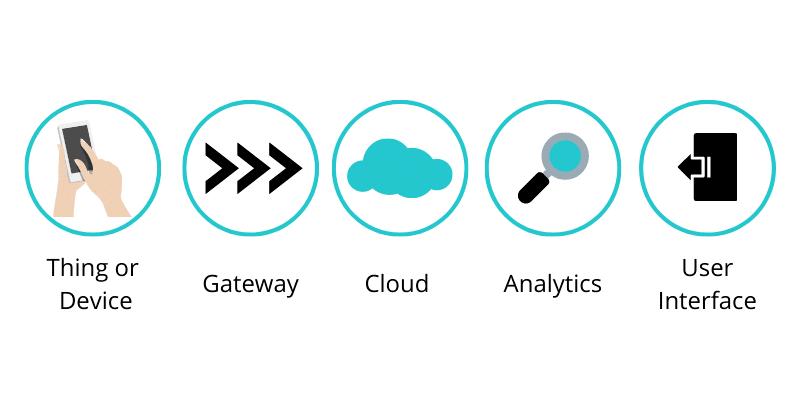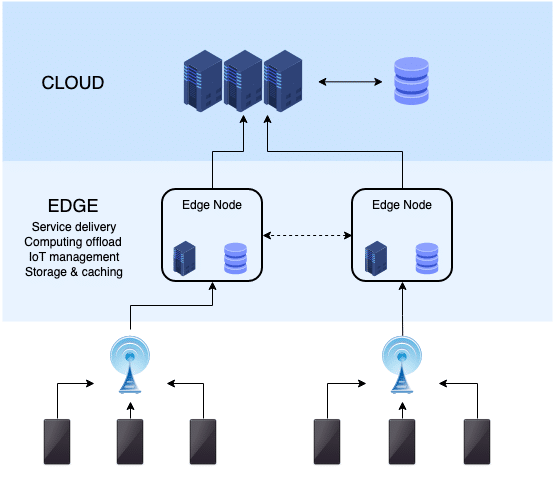How does IoT fit in with the concept of cloud computing?
July 27th, 2020
We can find IoT as a part of smart home solutions, healthcare devices, tools in business environments across different markets. Each of these devices collects a huge amount of data which turns out as a burden for the internet infrastructure. That’s why more and more businesses looking for an alternative that could decrease this strain. Cloud computing allows companies to use up a computing resource, like a virtual machine or container rather than develop an individual infrastructure. In this article we’re going to discuss the role of cloud computing in IoT and why IoT and cloud computing are indivisible.
Is my refrigerator really in the cloud?
Well, technically, it should be physically located in your kitchen or break room or garage. However, if you are talking about all of the millions of pieces of data it collects over the course of a day, then your past, current, and predicted future are metaphysically in the metaphorical cloud. The Internet of Things (IoT) is well known, and by technology standards, old hat. However, it isn’t going away. It might be blasé to talk about IoT, but the offsite storage and computation of all of the collected data from every IoT device in the home of every individual across the country and world is big business, and will only get bigger.
Each is its own creature. IoT operates on the principle of interconnecting devices with a central or home network. Each device communicates via the network and assists or monitors certain digital functions. The function could be a video camera, temperature sensor, microphone, light switch, alarm, lock, location monitor, or pet feeder. If it can be digitized it can be datamined for a consumer cost. Cloud computing, on the other hand, is the classical principle of an offsite server connected to remote consoles. Remember those really old computers? At a point in time before the desktop, central services delivering data to discrete individuals were common. Well, it’s back, except the remote server isn’t in the building but is in multiple data centers across the world. The purpose of cloud computing is to harness the unlimited computing power of near-unlimited drivers (well, as many as you can afford). Applications, processing, rendering, and storage can all be done off-site and delivered in an instant to anyone with a mobile or wired connection to the Internet.
IoT and cloud computers create symbiotic business relationships. Cloud computing may have SaaS, PaaS, or IaaS as a product but with IoT, it is able to develop not only a connected home device that can be monitored, it creates a product that is scalable instantly to any market on the globe with the increased application, speed, and deliverability without the infrastructure requirements or the constant capital investments. You create the device the cloud makes it relevant.
Cloud computing is the scalable IoT solution
As mentioned above when you think of IoT, you have to think of big data. With great monitoring comes great amounts of data. The solutions to delivering, storing, securing, analyzing, and re-deploying, should not be the focus of your company or a brand. Rather, the focus of the company needs to be on the IoT device and functionality. Cloud computing takes the burden of the corporate servers and installs it into any number of secure data centers across the globe. Here are the primary benefits IoT develops when partnered with Cloud Computing.
Benefits of Cloud Computing
Remote Processing Power
Most homes in the future will have multiple IoT devices. Most homes may not have the capacity to be able to store or process the information needed. Further, businesses may have even more data and not near enough capacity to deal with the information gathered from their IoT devices. Instead, the cloud capacity is reliable. Servers come on as needed and as demand rises. Dedicated cloud infrastructures deliver speeds only limited to the amount of power rented and the capacity of the technology. There is no longer any limitation on the company or user’s technological abilities.
Security and Privacy
Cloud servers are in the business of good business. Their business is protecting the assets of the client, not allowing anything to be breached or leaked. Strong security measures, effective authentication, and standardized high encryption protocols are commonplace and expected with any legitimate cloud infrastructure service provider. Governments, healthcare professionals, bankers, lawyers, and security professionals all rely on the ethical standards cloud computing holds as far as security and privacy.
Low Entry Barrier for Smaller Enterprises
Cloud computing hosting services have evolved into a click and start service. There are no length coding sessions. At most, it is a quick phone call to an outsourced tech rep or inhouse sales rep. Most of the hosting services can deliver quality products as quickly as you can type in your credit card at extremely reasonable rates. IoT development companies want to invest in the infrastructure required to develop the product, not in services to build a server farm. Cloud computing hosting companies allow start-ups, soles, or even major players in the IoT world to pay a minimum price for only the computing power they need and only when they need it.
How does Cloud Computing improve the functionality of IoT
Sure, the service is cheap and offsite. It is the standard outsource model that is applied in just about any field in any industry that requires other specialized services. However, IoT actually improves in its functionality when paired with cloud computing. Here are the two main ways cloud computing increases IoT’s efficiency, functionality, and productivity.

Location, Location, Location
There is that old saying in Real Estate. It is all about the location. Cloud computing isn’t just an offsite server farm. It is a connected web of server farms that are all located across the world. This means that your client doesn’t have to access a server in your building or in the single server farm building. Your clients’ IoT devices will connect to the server farm closest to them that holds their account. This increases speed, connectivity, and efficiency. Communication over long distances can cause a lag. With multiple access to multiple servers based on the user’s location, cloud computing can actually decrease the lag and increase the speed needed to access real-time information instantaneously.
Scalability
Normally if you were going to deploy an infrastructure of IoT devices in another market you would have to gain a physical footprint and develop IT centers and support services. However, since all of the data and information is processed and stored via distributed networks everywhere, there is no need to establish a physical footprint. Rather, the cloud has already done that advanced planning for you. All you would need to do is review your contract to ensure that your hosting provider can support that market. If so, you only need to deploy your product, not yourself into that market or any market around the world.
Challenges of combining IoT and cloud computing
There are hurdles to the entry of cloud computing into the market for industry and consumer IoT devices. It is all still developing in real-time. Here are a few issues that will still need resolution before the marriage of IoT and cloud computing is complete.
- Data Ownership:
Should or Do you have complete control over the data collected by your IoT device? What are those legal ramifications for privacy law or government intrusion? - Up-Time Reliability:
If your device fully stores and analyses everything on its own then you never need to worry about server downtime. The internet goes down. No hosting provider can ever guarantee 100% up-time. If they are then you may want to look elsewhere. - Lag-Time:
Sure, data centers make communication quicker, but it will always be slower than if the data were analyzed in house by the device. Though, this often can’t be accomplished due to the processing limitations on the device itself.
The future of fog computing
Instead of decentralized coup computing data centers, there is a movement growing to have some processing power available at each location. Think of it as a modern-day local server. Some devices could be handled by onsite server power. Edge computing (fog computing) is the practice of returning (or re-returning?) to the local server that collects, monitors, stores, secures, processes, and redeploys the necessary information and data.
With billions of IoT devices on the market being used, computing power will need to be flexible, accessible, stable, and reliable. If a single user in a single location is the only user for a certain IoT device then cloud computing could be moved to fog computing, thereby decreasing the reliance on your contracts. Fog computing, or edge computing, will grow. The IoT devices on the market and the data requirements will only continue to grow.

Should you use serverless architectures for IoT solutions?
Like all good questions, the answer is a resounding: it depends! Before answering this question, you need to ask a few more. There is no one size fits all cloud hosting service that will revolutionize everything. Cloud computing is advantageous because it is time and cost-effective for the company, but it really just depends on the product the company is making. This can be a difficult question to answer. Here are a few questions to start out with:
- What kind of data is involved?
- Are there unique processes involved?
- Are there unique applications involved?
- How much data is involved?
- How quickly is the data delivered or retrieved?
- How many users will there be on the cloud at any given time?
- Does the device have the ability to locally host the data/app/security?
Depending on the answers to these questions, you may come to the conclusion that cloud computing just isn’t needed. Cloud computing isn’t free, nor are physical serves. Maybe starting physical is better and then transition to decentralization. Maybe the opposite is more cost-efficient for your data needs.
Death, Taxes, & Massive Amounts of Data
In 1789 Benjamin Franklin said that “in this world, nothing can be said to be certain, except death and taxes.” He should have included “change” into that idiom. If you are the harbinger of change don’t allow network connectivity issues to take the wind out of your sails. Find a solution that fits your future vision of your product. Direct the future path instead of allowing change to come to you. If you need advice or help don’t hesitate to reach out to us. We can step you through this process and make sure you stay focused on your product and success.
Main benefits of Cloud Computing?
First of all, one of the benefits is remote processing power because dedicated cloud infrastructures deliver speeds limited only by the amount of power rented, the second benefit is strong security and privacy, effective authentication, and standardized high encryption protocols, and third is a low entry barrier for smaller enterprises.
Which features of Cloud Computing can be useful for IoT?
Localization (IoT devices will connect to the server farm closest to them in so increasing the speed of connectivity)
Scalability (since all of your data is stored via distributed networks everywhere, you don’t have to establish a physical footprint)
Are there any issues I can face in combining IoT and cloud computing?
Data Ownership (most companies transfer their IoT data to third parties for regulatory reporting reasons or to monetize data), Up-Time Reliability (No hosting provider can ever guarantee 100% up-time, so you have to find reliable solutions), Lag-Time ( data centers make communication quicker, but it will always be slower than if the data were analyzed in house by the device).










